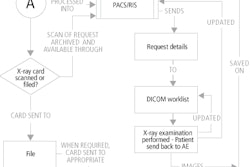Bringing filmless imaging to an orthopedic clinic confers workflow improvements and is well received by both orthopedic surgeons and patients, according to Dr. John Wandtke of the University of Rochester Medical Center (URMC) in New York.
"Workflow improvement in radiology is both good for (radiology) and for orthopedics," Wandtke said. "(With a digital orthopedic clinic) we save time, and time these days is money. With enough planning, this type of system works."
Wandtke, who is medical director of PACS at URMC, discussed his institution's two-and-a-half years of experience with a digital orthopedic clinic at PACS 2004: Working in an Integrated Digital Healthcare Enterprise, sponsored by the University of Rochester School of Medicine and Dentistry in San Antonio.
Two-and-a-half years ago, URMC opened a new outpatient clinic two miles from its main facility, and took the opportunity to implement a fully filmless operation, Wandtke said. At the clinic, 300-500 patients are seen each day, with 150-250 x-ray exams performed. If a patient's old exams are not in the PACS network, the patient's radiology folder is transported to the clinic each day.
Approximately 50,000 x-ray exams are performed per year, up from 30,000 initially. The clinic has seven x-ray rooms, including two DR and five CR units. MR and CT studies are scheduled at the hospital or an adjacent private office, and all exams are on the same PACS network.
Planning
To plan for the workflow changes that come in a digital environment, weekly meetings were held for several months with the radiologic technologist and clerical manager, orthopedic nurses and clerical managers, as well as orthopedic surgeons, Wandtke said.
The PACS filmless plan also involved convincing almost all the orthopedic surgeons that digital image quality was as good as, or better than, film, a process that took about a month, Wandtke said. Image processing parameters on the CR system were also adjusted to satisfy them, he said.
"We did have to tweak our CR settings to show the kind of detail the orthopedic surgeons are interested in," he said.
The PACS had to be always operational, with a backup, parallel system that offered 100% redundancy, Wandtke said. URMC also placed heavy emphasis on training, providing initial one-on-one training for all 60 orthopedic users.
The radiology department also has a full-time trainer, who is a former technologist. Prompt orientation and training is provided for all new PACS users.
Computer workstations were provided in all 60 patient exam rooms, but no view boxes. Two computer workstations were provided in each of eight physician work areas. PC and PACS support was available from a help line during clinic hours, Wandtke said.
Workflow gains
In the new workflow environment, orthopedic surgeons can review old or new x-ray exams with their patients, either outside or inside exam rooms very quickly, he said. All radiology exams are in chronological order, and can be reviewed with a colleague more easily using the Web-based PACS.
The radiology department is now able to frequently escort patients back to the orthopedic exam room right after the exam is performed, a change from past workflow wherein patients would wait around in the department for the images to be printed, Wandtke said. And no patients are "lost" in the radiology waiting room, he said.
Orthopedic surgeons like the filmless system. The radiology service provides old exams 95%-100% of the time, provides faster turnaround for x-ray exams, understands orthopedic's need for efficiency, and will do whatever it takes to produce optimum workflow, Wandtke said.
The radiology manager meets monthly with orthopedic operations staff to solve any new workflow problems, he said.
Patients also appreciate the ability to see their imaging exams with an orthopedic surgeon in a private exam room, rather than a hallway, Wandtke said. They also benefit from shorter waiting times, never being "lost" in radiology, or having to reschedule their exams because of a lost radiology exam.
There were some workflow accommodations made, including, for example, making film or hard-copy results available for patients going to the OR. However, computer workstations will be installed in OR rooms during the next year, he said. For patients going to another hospital or clinic, film/hard copy or a CD is available.
Radiology also benefits from the decreased need for film folder transport, requiring fewer clerical staff and a less strenuous workday for the rest. In addition, the unit receives fewer complaints about lost films and long waits for patient x-ray exams, Wandtke said.
Digital imaging enables elimination of repeat exams, and radiology staff feel more productive, he said.
Still, some unsolved workflow issues remain, Wandtke said. Radiologists don't have an easy way to access outside x-ray studies, and need an easier way to digitize outside films, and add CT or MR exams to the PACS network, he said. Some orthopedic surgeons also provide limited QA feedback, requiring more joint conferences.
Overall, while PACS workflow is different, it can easily provide improvements for both radiology and clinics, Wandtke said.
"We've had great success with it so far," he said.
By Erik L. RidleyAuntMinnie.com staff writer
April 13, 2004
Related Reading
New wireless network options offer benefits, despite security concerns, April 2, 2004
Task automation drives workflow enhancement, March 15, 2004
PACS success relies on QA/QC procedures, March 12, 2004
Italian hospital finds that PACS doubles costs, March 5, 2004
SCAR members offer solutions for data deluge, February 24, 2004
Copyright © 2004 AuntMinnie.com


















